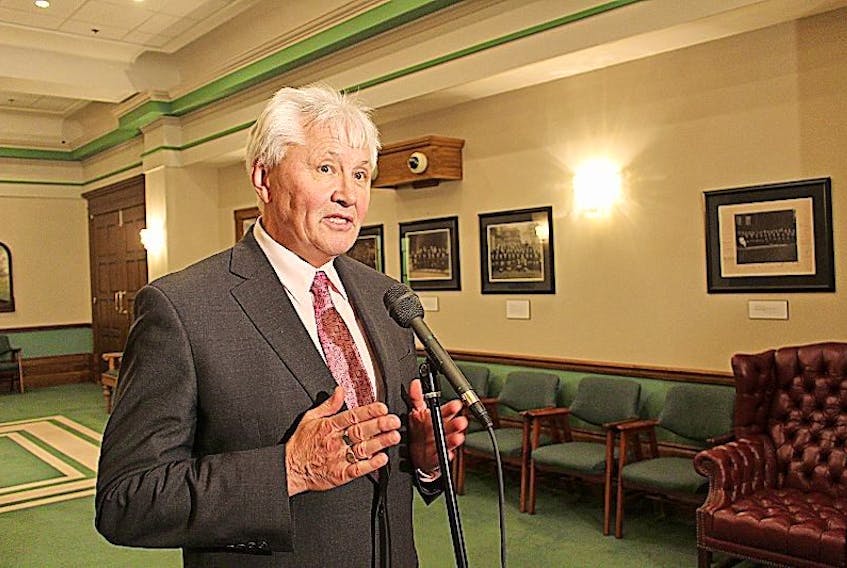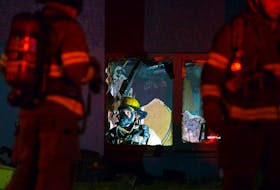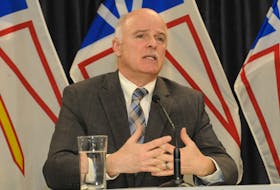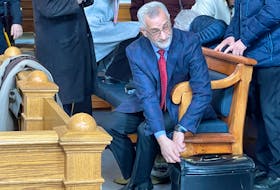There is a cost to Canada’s climate change goals and greenhouse gas emissions reduction plans, but who is going to pay in Newfoundland and Labrador and just how much remains an unanswered question.
The Progressive Conservatives have asked for the details more than once in the latest session of the House of Assembly, with no success.
“The answers have always been a bit muddled,” Environment critic Barry Petten told The Telegram Tuesday. “They’re not clear.”
He said the repeated promise of a “made in Newfoundland and Labrador” plan has become a tired talking point, given it doesn’t provide information.
“They don’t answer when they get asked about it. I don’t think they know themselves,” he said.
Premier Dwight Ball has said complete details are coming in the spring.
RELATED STORIES:
N.L. carbon pricing plan to be unveiled next spring: Ball
Details sparse on N.L. offshore carbon pricing plans
RELATED LINK:
N.L. industrial emissions baseline data — year one
On Wednesday, Environment Minister Eddie Joyce told The Telegram the time is being used to continue discussions on more than one front — trying to minimize any negative fallout from final decisions.
“We’re in discussions with the federal government over this, and the offshore is a big part of it and our (land-based) industrial is a big part of it also,” he said.
Joyce named a handful of oil- and mining-sector facilities playing a significant role in the provincial economy and said he has spoken with federal representatives about the need for the province to remain competitive in those sectors.
“We’re in contact with the industrial players here to ensure that they’re competitive for that and, if not, we’re going to lose jobs here in Newfoundland and Labrador,” he said in response to Petten’s criticism.
What about other provinces?
Canadian provinces have different positions in response to the federal push for carbon pricing and greenhouse gas reductions.
British Columbia and Alberta have a tax in place. Ontario, Quebec and Nova Scotia are part of cap-and-trade systems, with additional changes announced for some in 2018.
Like Newfoundland and Labrador, Prince Edward Island and New Brunswick have yet to provide full carbon pricing plans, promising more early in the new year.
Manitoba has announced a $25-per-tonne tax beginning next year, but remaining steady through 2022. And given the difference between this and the federal expectation — a minimum of $10 per tonne carbon price paid in 2018, running to $50 per tonne in 2022 — that province and Ottawa are now at odds.
Saskatchewan initially refused to price carbon, but, as the CBC reported this month, the province and Ottawa are talking.
Plenty to consider
A single province’s carbon tax does not necessarily stay within that province. For example, power customers in Prince Edward Island may pay added costs as they are put to NB Power — a main supplier to P.E.I.
For Newfoundland and Labrador, Joyce said Marine Atlantic and the ferries within the province are a part of ongoing discussions, as are flights between Newfoundland and Labrador and other provinces.
As the CBC reported in June 2016, when Alberta brought in its carbon tax, only in-province flights were affected there (the added charge will be 7.75 cents per litre of jet fuel in 2018).
“There are a few issues like that. If you fly from Nova Scotia to Newfoundland,” Joyce said, “who pays the carbon tax?”
What about the gas tax?
In June 2016, there was a significant hike to the taxes applied to gasoline in the province, but unrelated to carbon pricing. The 16.5 cent per litre increase was an effort to boost provincial revenues.
In June of this year, there was a rollback of 8.5 cents per litre of that hike and, on Friday, there will be another four-cent rollback.
“There will be a remaining figure left on — I think it’s four cents left. What we’re going to do then is try to phase it out before the carbon tax is brought in. That is our goal. That is our plan,” Joyce said.
The minister was asked directly if the added tax on gas was being rolled back only to go up again as part of carbon pricing.
But he would not say what Newfoundland and Labrador’s carbon pricing approach will include, or not include.
Reporting and enforcement
Legislation brought in provincially in 2016 — the Management of Greenhouse Gas Act — was more about establishing monitoring requirements for large, industrial sites and stating planned enforcement than how carbon costs will be distributed.
The law permits anyone 18 or older to file a complaint relating to industrial emissions, prompting an investigation. Inspectors, designated by the minister, will have the right to enter premises (not including a person’s home) without a warrant in order to investigate.
The minister has the power to shut down industrial sites. The government can also demand mitigation measures before work at a site continues. In the case of any stop-work order, the related costs incurred by a business are not recoverable from the province and there is a protection against personal liability for any actions taken by inspectors in good faith.
A first-offence fine for violating reporting requirements has been instituted at not less than $50,000 and not more than $1 million, or imprisonment for not less than a month or more than six months, or both a fine and imprisonment.
The province first needs baseline emissions monitoring, for baseline numbers. The results from the first year of a two-year program to collect baseline data were made available online Wednesday.
What about Muskrat Falls?
Progressive Conservative Barry Petten said this week his party believes there must be greater recognition for the Muskrat Falls project in the context of carbon pricing and emissions reductions.
“We’re paying our fair share of carbon tax in Muskrat Falls,” he said.
Critics have said the Muskrat Falls project has also required the destruction of natural vegetation covering the dam and reservoir site, and along more than 2,100 kilometres of cleared transmission line corridor (including the Labrador-Island Link, Churchill Falls to Muskrat Falls connections and the Maritime Link lines). Less vegetation means less natural carbon dioxide processing.
Newfoundland and Labrador Hydro is not required to track and report Holyrood Thermal Generating Station emissions for the province in the same way as other industrial emitters, given the main outputs are expected to come to an end as a result of the Muskrat Falls project. However, Hydro volunteered numbers for 2016 and those numbers were released to The Telegram Wednesday.
The facility is stated as producing 1.35 million tonnes of carbon dioxide equivalent emissions in the year — more than the Come By Chance refinery, the Iron Ore Company of Canada operations in Labrador West or any other operation. The province has recorded another 115,000 tonnes as being produced from the additional gas turbine at Holyrood.
Emissions were already being reported to the Government of Canada, and there is some difference between the provincial and federal reports, given differences in reporting requirements.









